This content has been archived, and while it was correct at time of publication, it may no longer be accurate or reflect the current situation at Microsoft.
Moving to the cloud requires more than just technology-it demands a new approach to managing services. For the Office 365 service management team at Microsoft, the employee experience is our top priority. We’re focusing on end-to-end services and aligning IT skills with strategic roles. We deliver frequent Office 365 updates in shortened release cycles with new governance models to help protect corporate assets while promoting collaboration. It’s paying off-we’re seeing employees adopt the services and enhance productivity.
IT organizations in global companies are under tremendous pressure to support their company’s digital transformation. To maintain a competitive edge, technical decision makers need to adopt solutions that connect teams and people around the world and that empower employees, optimize operations, and transform products to best serve their customers. And with shrinking budgets and compressed release cycles, IT needs to achieve results more quickly and more efficiently than ever before.
The cloud adoption mandate
As the business demands faster, more agile, and less costly solutions to achieve their digital transformation, cloud computing offers a compelling way to meet ever-increasing user needs. The cloud delivers the very latest versions of apps that can enhance employee collaboration and productivity, which in turn accelerates great customer outcomes.
However, transitioning to the cloud can create growing pains for IT organizations because the old emphasis on server maintenance, applying patches, and other activities in the datacenter isn’t relevant. IT leadership needs to undergo a fundamental shift in thinking about how services are delivered and managed, what value these services bring to the business, and what shifts in organizational roles and mindsets are needed to realize benefits.
If you are a technical decision maker helping drive innovation in your company, what does service management mean to your IT employees when they no longer manage servers? In the new digital world, service management isn’t just about pushing changes out to users; it’s about helping to articulate business goals, and then creating a plan to achieve those goals. You’re shifting mindsets, not just deploying new technology. You’ll need to restructure your service management processes, transform IT roles to higher-level functions that increase their value to the business, and think about governance and communications in new ways.
When success is measured in increased employee productivity via increased service adoption rates, IT needs to embrace a user (employee)-centric mindset. Every aspect of service management must be viewed under an end-user lens to deliver the tools, services, and information employees need to do their jobs faster and better.
Shifting from servers to services
At Microsoft, we recognize that the value of IT shifts as business evolves. As a result, we constantly adjust the engagement and boundaries between Microsoft Digital and the business. Today, the success of our IT organization is measured by its contributions to business results. In support of this business model, our IT strategy centers on service management, doing everything we can to demonstrate value to our fellow employees and to promote adoption of these tools and services. This same IT strategy is reflected in how we approach our own internal service management.
Figure 1 illustrates that, as we continue migrating employees from on-premises–based systems to Office 365, we’ve shifted our focus from maintaining servers to concentrating on how our services can benefit our fellow employees. For example, the types of services we provide our organizations are aligned around collaboration, email services, unified communications, and meeting experiences.
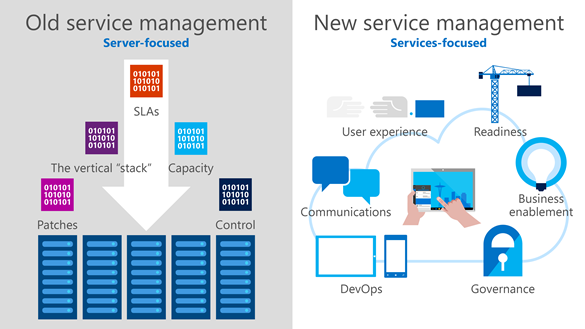
Shifting the role of IT
IT departments across the industry are facing changes on every front. At Microsoft, our IT department and our roles are also changing. Service management is focusing not just on the technology but also the people. Here, we compare what service management used to focus on versus what we emphasize today.
Our old focus: Servers and slow, perpetual upgrades
In the past, a key responsibility of the Microsoft Digital service management team was maintaining the on-premises servers that delivered our business-critical communications and file storage systems, including Exchange, Skype for Business, and SharePoint. Like many enterprise IT organizations, when the bulk of our systems were on-premises, our focus was on server availability and control—applying patches and upgrades, defining server policies, maintaining availability, and ensuring adequate capacity.
When we had two or three years between major product updates, we could do compatibility testing well in advance of new builds to minimize any potential issue with other integrated systems and business-critical applications. We began testing in a development environment, moved to a test environment, and then slowly released the update into the production environment.
In this environment, each team was deeply technical around their own set of systems, but they had little interaction with other groups. Moreover, the technical expertise that an employee developed within one area made it difficult to transition into other areas. A siloed culture often hampered collaboration with other groups, which led to duplication of effort and inefficiency.
Our new focus: Services
The first thing we are changing as we move to the cloud is our mindset. We’re no longer thinking about building individual applications or infrastructure capabilities and delivering big, multi-year projects. Instead, we now deliver end-to-end services such as Office 365 where we make agile, continuous updates. We work in more agile ways, and we recognize business-driven technology choices in our business groups instead of trying to keep control within our Core Services Engineering organization. And we’re fully committed to this—every employee in Microsoft is focused on our services mindset.
Today, we examine every role and task for business value. We constantly look for ways to accelerate and improve capabilities for our employees, enabling them to connect with teams around the world and improve productivity.
Key takeaway: Educate everyone on the new service management mindset, and what it means to their role. Successfully driving such a transition requires that everyone understands where they fit into the new order. This means:
- Leadership must communicate the changes with transparency and clarity, explaining the “why” and the “what” of the change, and the importance of the change to better align the organization with strategic business goals. Make reinvention your culture and integrate change management into everyday processes and feedback channels that help leadership gauge their efficacy.
- Employees must embrace this cultural transformation, moving from a siloed mindset to one that embraces agility and collaboration. Educate employees on their importance and value in change management and how they are the drivers of change in their environments.
In our service management teams, we redeploy our Core Services Engineering personnel to increase our strategic contribution to the business. We have de-emphasized the nuts and bolts of IT—the more commoditized aspects, such as maintaining server space or hardware—because that functionality now comes from Azure. What’s becoming more important is developing conceptual network and programming language skills, as well as using strategic business skills to work closely with business groups. Our service managers need to understand Microsoft services end-to-end, including cloud-based services, protocols, apps, network access, devices, and even usage and user experience scenarios.
Promoting a people focus in service management
As service management evolves at Microsoft, our service managers are expanding their focus beyond deploying technology—they’re thinking holistically about the people side of change as a part of creating a service. At the highest level, they are focusing on:
- Driving service adoption. In the cloud-based services model, deploying updates is only the first step. Getting our employees to adopt the new productivity tools and services is what ultimately accelerates the business. Why is adoption so critical? If no one is aware of an update or understands how it can help them do their job better, the feature won’t be used—and our efforts to improve productivity will stagnate. As an example, the ability for teammates to coauthor documents online is much more efficient than emailing different versions of a document as attachments; it also removes the risk of one person overwriting or losing another coworker’s changes. We will see a productivity gain only when the team adopts this new way of developing documents.
- Incorporating change management skillsets. Change management is a skillset we’re beginning to add to our organization. It’s not a formalized title, but teams and service managers are thinking about processes and tools that help manage the people side of change to achieve a desired outcome around their service.
- Devising communication and readiness frameworks. As part of creating a service, service managers and their teams are investing in frameworks around communications and readiness, and thinking about ways to reinforce new behaviors. An example is establishing “mentors” in the form of champions who help reinforce new behaviors around collaboration. These are the mechanisms we use to communicate to our workforce in a language that emphasizes how these new ways of working can streamline their daily tasks. This is the evidence our employees need to spark the behavioral change, adopt the new technology, enhance productivity, and ultimately accelerate the business.
Shifting from multi-year releases to frequent updates
Because we now manage cloud-based services, handling patches and updates are things of the past for Office 365. Instead, the cloud-based services are updated by the DevOps engineers who write the code. Changes are made in the cloud with a multi-way active topology that shields the user from these update processes, such as automatically failing over to another server if the current system is being patched. For the server-side services, this all happens in the background and is transparent to users, thereby making it a much better experience for them.
This seamless update approach means that our organization doesn’t need to inconvenience people with messages about maintenance windows or scheduled upgrades for our cloud-based services. It also enables product engineers to push out enhancements to the Office 365 services much more frequently. The three-year release cycle for new technology and capabilities has been replaced with regular releases, and product teams learn from usage statistics to improve experiences in near real-time.
In Core Services Engineering, we continue to take advantage of Content Delivery Network (CDN) to manage deployment of our Office 365 ProPlus releases directly from the cloud, avoiding the need to manually download and replicate these updates. Employees automatically get updates from the CDN over the internet according to their update channel schedule. We also support our on-campus employees with System Center Configuration Manager when we need more control over the update process. Configuration Manager is now integrated with Microsoft Update service and can automatically deliver updates to our internal users. This reduces traffic through the firewall and gives us a consistent process to discover, view, deploy, and track software updates just like we manage other apps in our organization.
Table 1. The three different Office 365 ProPlus update channels and how we use them at Microsoft
| Monthly Channel | Semi-annual Channel (Targeted) |
Semi-annual Channel | |
| Client population | Less than 1 percent | Approximately 10 percent | Approximately 89 percent |
| Purpose | Monthly updates with the latest features | IT pilots, application validation, and end-user acceptance testing before broad deployment | Broad deployment |
| Target audience | Representative end users, developers, and ISVs | IT testers, app and add-in owners, representative end-users | All enterprise end users |
| Release frequency | Monthly | Twice per year, in March and September | Twice per year, in January and July |
Note: The names of the update channels and their frequencies of update we reference in this paper are based on the changes to the Office 365 ProPlus and Windows 10 update models that will go into effect in September 2017 (“Current Channel” becomes “Monthly Channel,” “First Release for Deferred Channel” becomes “Semi-annual Channel [Targeted],” and “Deferred Channel” becomes “Semi-annual Channel”).
Key takeaway: Examine every facet of your release process. In addition to groups and roles, service managers need to consider other aspects of their environments to give the best release experience, like:
- Consider the people and their roles when deciding which update channel to place them.What users should reside in which update channel? There is no single correct answer for who belongs where, but there are key data points you should consider when placing people in the more accelerated channels. At Microsoft, we factor in a person’s risk aversion; any application dependencies, such as with business-critical apps; and even their appetite for embracing change to determine the best fit.
- Identify the necessary cloud-based and client components of your solution. As a service manager, you need to be aware that there is a strong correlation between a client product like Office 365 ProPlus and Exchange Online. There will be new functionality, such as focused inboxes, that are supported only by Exchange Online. If part of your infrastructure is still using on-premises–based Exchange servers, employees won’t see that new feature in Outlook, even though they’ve updated their app to the latest release. Keep these code dependencies in mind when you’re evangelizing new capabilities to your employees.
- Develop a useful readiness toolset. It can include:
- Self-help tools for specific actions (such as setting mailbox permissions) that streamline the learning curve for new features while simultaneously reducing help desk requests.
- Dynamic feedback mechanisms that use Microsoft PowerApps for surveys, and social listening channels such as Yammer, and others.
- A scalable user-readiness implementation plan that is used to align the company’s readiness process with the business’s chosen release cadence.
- A portal that provides an authoritative source of information about services.
- Service reports that track service health and user population.
- Develop a change management standard operating procedure checklist. Documenting your change management process and following a procedural checklist is critical for minimizing the potential for major hiccups. We use a detailed proof of concept (POC) checklist that starts with assessment planning; we hold key reviews for security, HR, and other stakeholder groups; and then we perform a POC and/or pilot rollout with a smaller group of savvy users who have volunteered to test and provide feedback before updates are moved into production environments.
Office 365 features that help manage change
For service managers to make informed decisions about client update releases, they need to know what new and updated features are included in each release. This knowledge is key to understanding the end-to-end functionality of their services—and in helping other departments identify changes that might impact them (such as helping the Legal department identify functional changes that might intersect with regulatory requirements).
Our service managers use the following resources to help them take a proactive approach to change management:
- Message center (located in the Office 365 admin center) is a dashboard that provides the most up-to-date notices of releases or issues.

- The Office 365 Admin app installs onto a smart phone—it helps IT personnel receive notifications, add users, create requests, and more, even when they’re away from their desks.
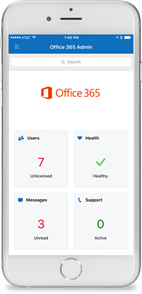
- The Office 365 Roadmap offers a detailed view of updates in all stages, including launched (which are fully released into production), rolling out (as pre-release), still in development, and even previously planned updates that have since been canceled.
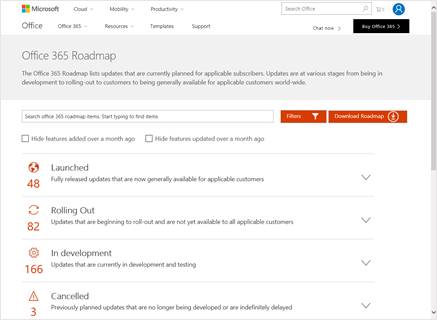
- The Office TechCenter Office 365 client update channel releases page is updated regularly with information about all the channel releases for Office 365 client applications.
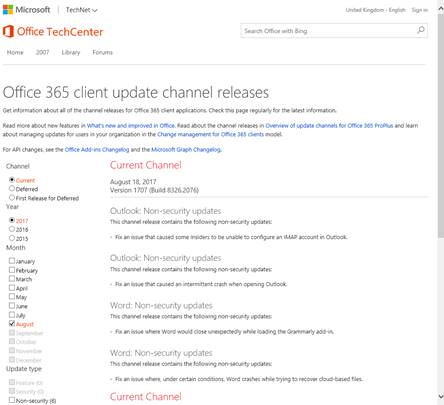
Empowering people through governance
As we focus on delivering services, we want to empower our employees and ensure that they can collaborate and get their work done. However, we must also protect corporate assets and hold employees accountable if they inappropriately share confidential information. The challenge today is striking the right balance, so carefully reviewing our governance goals is key. If we don’t provide sufficient governance, we aren’t protecting our assets. But when governance is overbearing, employee productivity and collaboration drop, and people find other ways to share information.
There is no single correct approach to content governance. We work closely with the business to understand how they can create the right solution on top of the technology and, as a result, extract more value from our services. We look at how different people and teams communicate and collaborate, what specific tasks they need to accomplish, the types of information they share, how it should be stored, and so on. By identifying the details in the workloads and what people need, we can apply the appropriate classifications on our data and set policies in alignment with our business goals that let the right people access and share the information they need to accelerate the business, maintain security, and ensure accountability.
Key takeaway: Work with the business to understand user scenarios so that you deliver the appropriate feature sets to the right groups or regions. Good governance is all about making the right decisions about how your IT organization manages your services. Who should be allowed to do what? How do you want to encourage collaboration in your organization? What limits do you need to place on collaboration—should everyone be allowed to collaborate externally with partners? What needs to be protected, and at what level? What are the limits and legal restrictions you need to impose on whom and what? What retention should you put in place? These are all considerations that directly influence the services, features, and permissions that you set.
Using Office 365 groups to govern holistically
Our holistic view of Office 365 services is reflected in a new type of membership, called an Office 365 Group. It ringfences individuals and gives them access to shared infrastructure such as mailboxes, sites, and Teams. Microsoft employees can create their own Office 365 Groups. They can add people and provide them access to the Office resources they need in an integrated experience—which in turn helps facilitate collaboration and increases productivity across the entire Office 365 suite of services.
Capabilities available for Office 365 groups include:
- Microsoft Teams
- Shared inbox
- Shared calendar
- SharePoint Online modern team site with document libraries
- Shared OneNote notebook
- Microsoft Planner
- Yammer
Four levels of container and file classification
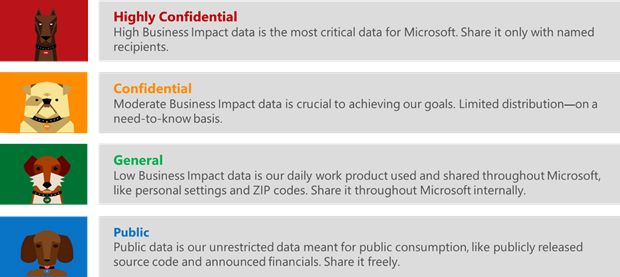
Another important aspect of governance is asset protection. At Microsoft, we believe that every data container—whether it’s a SharePoint Online site or an Office 365 Group with its various associated workloads—needs a classification, and every project should be classified. The classification schema we use has four levels of sensitivity:
- Highly confidential—for the most sensitive data
- Confidential—for data that should have limited distribution on a need-to-know basis
- General—for daily work information that can be shared throughout the company
- Public (P)—for unrestricted data
With these classifications in place, we can set policies to help protect sensitive information by restricting access to the appropriate set of people and establishing rules like Highly Confidential–labeled groups must be set to private. It also promotes productivity by automatically applying data protection. This frees our employees to focus on their work instead of worrying about performing manual data protection tasks.
Key takeaway: Use asset protection to enhance other types of governance. After you have asset protection governance in place, use that to enhance other types of governance throughout your infrastructure. At Microsoft, we use our classification data to:
- Ensure that the most confidential content repositories have the most aggressive retention schedules.
- Limit guest access to our most sensitive content.
- Ensure that there is active ownership for sites or groups—especially for those that contain sensitive information. Those that become inactive are either handed off to a new owner or deleted as appropriate.
- Signal the sensitivity of content through labels and alerts.
Enabling productivity and collaboration
Great teamwork and collaboration don’t just improve productivity—they help drive better decisions. At Microsoft, we work in teams—ad hoc teams, long-standing teams, and dynamic teams. The underlying element throughout all these groups is people coming together to solve business problems. We want collaboration to create a workplace that allows our employees to embrace diverse workstyles. Moreover, we believe that collaboration is core to productivity, like the dynamic work environment enabled by Microsoft Teams. This new productivity tool in Office 365 is helping us redefine how work gets done.
As an example, it’s all too common in the enterprise for people in different parts of the company—or even on the same team—to use different tools, services, and solutions to perform the same task. This can cause a disconnect when these same people need to work together on a project. Suddenly, information isn’t flowing easily between co-workers. Which tool or mechanism should be used? How should one work with an incompatible file type that came from the other? Productivity stalls as people struggle to determine which tool to use, where to store project files, or how to communicate efficiently with the local team to keep up-to-date on project issues.
When enhanced user experience and increased productivity are the end-goals of service delivery, service managers must deliver solutions that align to that objective. At Microsoft, we’re promoting the use of Microsoft Teams. Part of the Office 365 productivity suite, Teams is a hub that’s focused on enhancing teamwork. It provides a chat-based workspace with built-in access to SharePoint, OneNote, and Skype for Business, and it enables employees to work on documents within the app.
With Teams, our employees can work within a single interface, bring in information from multiple sources and systems, and collaborate with people from a variety of different teams throughout the company to achieve a common task or goal (such as a project). Teams acts as a one-stop shop that brings together the capabilities of other familiar Office 365 productivity tools, and manages the team- or project-related instant messages, conference calls, and document collaboration—all from a single app.
Teams also helps Core Services Engineering apply appropriate governance. Because Teams supports Office 365 Groups, it automatically applies the appropriate asset protection to content that’s associated with a team. Members of the team are granted access to the data without requiring a site owner to manually set privileges, and, for sensitive content, guest access is restricted by default.
Readying our people for change
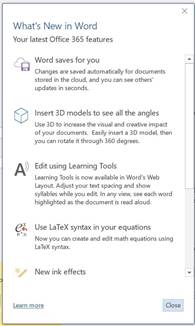
We’re always thinking about service management in terms of the benefit to the user, so we want to find the best way to communicate the value of a change to our employees. In other words, we’re shifting our focus from what the technology can do to the impact it will have on employees—will the update or new feature save them time? Will it make their work easier or automate a time-intensive task?
We don’t want our communications to become part of the barrage that Microsoft employees face every day, so a strategic marketing and communication approach is critical to our success. We offer guidance and context, helping employees know what to expect with each release, what to do, when to do it, and why it matters to them.
We also want to provide this information as unobtrusively as possible. As shown in Figure 7, the introduction of the “What’s new” pane into our Office apps enables us to provide details about key changes to each app when an employee launches it, delivering a “just in time” targeted message that emphasizes the benefits of utilizing the new feature.
Three steps for getting the word out in the right way
In Core Services Engineering, our dedicated communications team helps ensure that each update is messaged appropriately. Under their guidance, we carefully develop a communication campaign for every update.
Figure 8 shows how we help ensure a consistent, high-quality communications campaign by following three high-level steps in our IT Communications Framework.
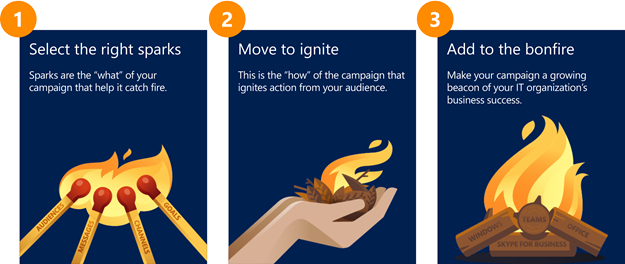
To elaborate on these steps:
- Select the right sparks. Sparks are the “what” of your campaigns. When the sparks are right, they will catch fire. During the spark process, you should:
- Identify your target audience.
- Define your key message.
- Choose the best channels.
- Outline any risks, dependencies, and known issues.
- Identify your desired outcomes and goals.
- Move to ignite. This is the “how” of the campaign. Combine your sparks into an ongoing engagement that ignites action from your audience. During the ignite process, you will:
- Build your communication and readiness plan.
- Create your detailed communications schedule.
- Produce content and creative deliverables suited for your sparks.
- Manage your campaign execution.
- Generate and review campaign reports, so you can see progress against your goals.
- Add to the bonfire. Every change communication or campaign should feed your bonfire—a growing beacon of your business success—so you can:
- Achieve sustainable business outcomes.
- Drive cultural change within your company.
- Establish social norms that encourage taking quick action.
- Draw people in to act and connect in new ways.
Key takeaway: Design an IT Communications Framework to standardize how you communicate change. Giving the right people precisely the kind of information they need for each update is critical. Because people on different release cadences will be receiving different features at different times, you need to first identify what information is relevant for people on each release cadence. Then, work with your communications team to identify the best communication channels to use for each campaign.
Above all, remember to reserve direct emails for actionable communications—such as situations where the employee must do something to prevent a service interruption. Use less intrusive communication channels for the informative messages, and emphasize how the changes can help employees do their jobs better.
Don’t forget to consider timing and cadences of the communications, too. For example, if we need to email employees about an important change, we try to schedule messages to be sent Monday through Thursday between 10 AM and 3 PM local time, with one message sent two days in advance, and another message the day of the change.
Using influencers to promote adoption and reinforce change
The first step in communicating the changes to services and apps is getting the word out—and the ultimate goal is to have employees use the new productivity-enhancing features regularly. At Microsoft, we’ve found that having influencers demonstrate and promote use of new technologies is the key to employee adoption. Influencers act as the spark that ignites the interest of the general employee population, encourages them to embrace the new feature or technology, and reinforces the behavioral changes that are necessary for successful adoption. After the communications campaign is in play, generating awareness with our employees, we work with two types of influencers to promote adoption:
- Leadership members should communicate directly to employees about the importance of incorporating new features into their workstreams. High-level sponsorship instills a sense of urgency and generates interest in the feature. Leadership can also highlight the new technology during town hall meetings, company presentations, and other live events to help promote adoption.
- Power users have deep knowledge of the technology. By incorporating the new feature into their regular workstreams, communicating to coworkers how the new technology benefits them, and answering questions about the technology, power users highlight the feature’s power, relevance, and value to employees.
Key takeaway: Give a face to the service. Consider having key service managers become the face of their service, taking employee suggestions, encouraging use of services and tools, and promoting collaboration. At Core Services Engineering, we’ve been using our Yammer group as a forum for such conversations. We monitor threads and respond quickly to anything that’s posted there. This helps people feel that Core Services Engineering is a people-first organization with a real desire help empower employees throughout the company.
Measuring the success of your message
Service management identifies the appropriate release cadence for employees and communicates messages about the value that the new features provide to employees, and influencers highlight the benefits of using the feature. After that, how do you know that employees are adopting the feature or the productivity increase that you can attribute to the feature? Answering these questions is critical for the business, so service managers need to re-align their metrics so that they focus on the client experience. This can include:
- Surveys. These can include both targeted surveys for a specific feature and general surveys to obtain overall satisfaction levels.
- Help desk metrics. This information can help determine a specific threshold (such as when passing beyond 10 percent of users opening tickets after a mailbox migration, and so on).
- Quality metrics. These can help you to see predictable trends in capability usage over time and examine the causes—both good and bad—of deviations.
- Usage reports. These are available in the admin portal and help you to gain insight into performance, availability, adoption rates, usage trends, and other metrics—including quality metrics.
Summary
In the new digital world, service management is shifting from a server maintenance mentality to a services mindset. The old priorities of applying patches, ensuring availability, and providing capacity for on-premises servers have been replaced with a mandate to add business value by delivering cloud-based services that will be readily adopted by employees and accelerate the business through enhancing employee productivity.
Our journey isn’t over. We’re still learning about the best ways to adjust our processes to cater to our employee needs and enhance productivity, but our efforts are paying off—our Core Services Engineering resources can focus on strategic projects, such as search quality and community management. We’re also seeing a better alignment of features to relevant productivity scenarios for our employees. Our influencers are helping generate interest in key features and releases, and employees are continuing to adopt these technologies. All these processes are working together to help accelerate business decisions by putting user productivity first—a good indicator that our journey is on the right path.





